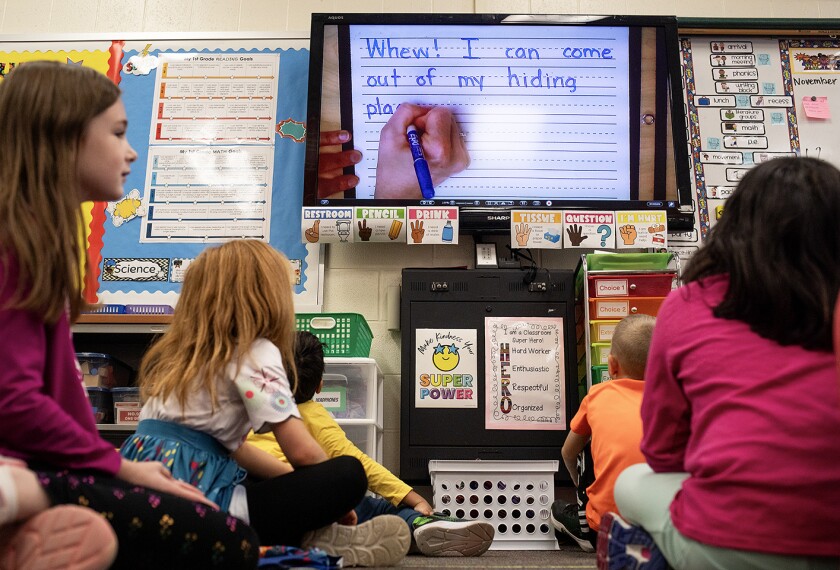This fall, as Kristin Farley’s preservice teachers started tutoring at a local school district, the first few weeks were consumed by logistics, especially scheduling: which tutors would be showing up to which classrooms to take which students when.
“It was a lot of putting out those small fires,” said Farley, an assistant professor of early childhood education at Wittenberg University in Springfield, Ohio.
Soon, the district and the university settled into a schedule that worked. But it wasn’t until this semester that they implemented the change that made the biggest difference.
Tutors started creating plans for the week ahead: an outline of what they would cover with students, targeted to each child’s specific needs and shared in advance with their classroom teacher. “It’s already so much smoother,” Farley said.
It’s also best practice. Experts say that purposefully aligning tutoring to curriculum content—like Wittenberg professors are now trying to do—helps kids get the support they need to be successful in class.
The goal is to give kids another “at bat” with the content they didn’t understand, said Shalinee Sharma, the CEO and co-founder of Zearn, a nonprofit math learning platform that has contracted with Tennessee to support that state’s tutoring program.
The approach is a key component of programs that studies have found move the needle on student progress. Even so, accomplishing this kind of alignment is complex and time consuming. And it can fall low on the priority list for districts that are struggling with more basic challenges, like hiring staff or retooling the master schedule to support tutoring.
Not all tutoring is alike
Tutoring has become one of the most common strategies schools are using to support students’ academic recovery from pandemic-related disruptions. States have invested more than $700 million of state ESSER funds to expand programming, according to an analysis by the Council of Chief State School Officers. Districts are investing many of their own ESSER funds into the practice as well.
But not all tutoring programs are alike. The high-impact variety—in which students see a tutor one on one or in small groups at least three times a week—generally have some mechanism to match up tutoring to classroom instruction, said Susanna Loeb, a professor of education at Stanford University and the founder and executive director of the National Student Support Accelerator.
Only one in 10 students actually get this kind of tutoring, though, according to recent federal data.
And much of schools’ energy right now is focused on program logistics—even though most district leaders understand that aligning tutoring to classroom instruction should be their ultimate goal, Loeb said. In fact, one study looking at a dozen districts found that those districts aimed to provide up to 60 hours of tutoring per year, but only supplied 12 to 14.
“Just getting the programs started takes a lot of effort,” she added.
‘Front-loading’ concepts through tutoring
Still, some districts have made instructional coherence a priority from the start.
In Lenoir City Schools in Tennessee, tutors follow a content schedule that dovetails with the curriculum in English/language arts and math.
Instructional coaches, one in math and one in reading, coordinate with teachers and tutors throughout the semester. “Since we are a small district, we know the scope and sequence of what’s happening in the classroom,” said Cherie Long, the K-12 math and science instructional coach. Lenoir only has three campuses—an elementary, middle, and high school.
The district is one of 87 in TN All Corps, a state tutoring model and funding program that offers school systems matching grants of up to $700 per seat offered for tutoring. Part of the Tennessee approach is a method that’s come to be known as acceleration.
I do think that as districts have success in tutoring, and see student learning ... then they’ll start to think more about how they embed it, and link it more deeply to the rest of the work they’re doing in schools.
The goal is for all students to be learning grade-level content. If children have gaps in their knowledge from previous grades, those are addressed in the context of grade-level work—rather than going back to reteach entire past units. (Read more about acceleration here.) It’s an alternative to remedial classes, which can trap students who are already behind on a lower track, while their peers continue to move forward to higher level material.
In Lenoir, this means “front-loading,” Long said. For example, 3rd graders are about to start a geometry unit. That means that tutors will soon begin reviewing with students what they have already learned about two-dimensional shapes, and previewing new concepts. That will ideally set kids up for success in the whole-class geometry lessons, Long said.
Long walks tutors through new content and helps them plan. “Because we’re included in those decisions and included in those data meetings, we’re able to see what the kids still need,” said Stacey Cantu, a math tutor in the district.
Long doesn’t have to develop the tutoring materials herself—those come through Zearn, the math platform with which the state has contracted.
The district doesn’t use an outside provider for reading, though, so the instructional coach in that subject has created resources herself—“a really large lift,” said Shawn Walker, the district’s student success coordinator. Still, he’s hopeful that this work put in on the front end will yield dividends in the long run, when future years’ tutors can use the plans the reading coach has created.
Building communication and support for tutors
In Lenoir, tutoring content is coordinated at the district level. Tutors use common resources and have similar goals with their lessons—e.g., prepare students for the 3rd grade geometry unit—even as they tailor specific support to individual student needs. Not all districts have been able to create these common supports.
But there are other methods programs use to align tutoring to instruction. The preservice students at Wittenberg, in Ohio, use their college instructors as a resource, said Farley.
The college students have some background from their coursework in how to teach concepts that their tutees are struggling with. But often, Farley said, “for better or worse, our tutors are learning this content as they go.”
The tutors get information about student needs from the kids’ classroom teachers, and then design activities with help from their instructors.
Creating a support system like this can be trickier in programs where tutors don’t have an education background.
Benjamin Morris, a cybersecurity consultant in California, is a math tutor at a charter school in the Los Angeles Unified School District. The organization he volunteers for, EnCorps, recruits STEM professionals as volunteers.
Morris has information about what their tutee is learning in math class, and the district provides them with materials to use. But Morris says he still wants more guidance on how to put those resources into practice.
Sometimes the student he’s working with is struggling to grasp an idea, and he’s not exactly sure how to break it down step by step. The biggest challenge, they said, is “needing to simplify constantly and make sure that it’s at a level that’s accessible for the students.”
The platform that houses tutoring materials for this Los Angeles school, a nonprofit called ASSISTments, has heard this kind of feedback from tutors. In response, the platform is planning on adding a new feature next year, said Britt Neuhaus, the group’s vice president of program and partnerships.
The addition will be able to recommend specific practice problems based on students’ abilities and areas of need, she said.
Such refinement is likely to continue in districts across the country as school systems move past the initial growing pains of launching tutoring programs, said Loeb.
“I do think that as districts have success in tutoring, and see student learning—and I do believe that’s starting to happen—then they’ll start to think more about how they embed it, and link it more deeply to the rest of the work they’re doing in schools,” she said.






